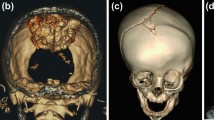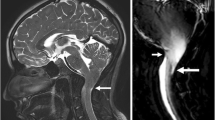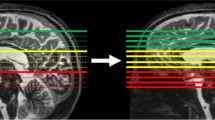Abstract
Pediatric neuroimaging is a complex and specialized field that uses magnetic resonance (MR) imaging as the workhorse for diagnosis. Standard MR techniques used in adult neuroimaging are suboptimal for imaging in pediatrics because there are significant differences in the child’s developing brain. These differences include size, myelination and sulcation. MR protocols need to be tailored to the specific indication and reviewed by the supervising radiologist in real time, and the specialized needs of this population require careful consideration of issues such as scan timing, sequence order, sedation, anesthesia and gadolinium administration. In part 1 of this review, we focus on basic protocol development and anatomical characterization. We provide multiple imaging examples optimized for evaluation of supratentorial and infratentorial brain, midline structures, head and neck, and intracranial vasculature.














Similar content being viewed by others
References
American Academy of Pediatrics, American Academy of Pediatric Dentistry, Coté CJ et al (2006) Guidelines for monitoring and management of pediatric patients during and after sedation for diagnostic and therapeutic procedures: an update. Pediatrics 118:2587–2602
Vincent JL, Shehabi Y, Walsh TS et al (2016) Comfort and patient-centred care without excessive sedation: the eCASH concept. Intensive Care Med 42:962–971
Campbell K, Torres L, Stayer S (2014) Anesthesia and sedation outside the operating room. Anesthesiol Clin 32:25–43
Ward CG, Loepke AW (2012) Anesthetics and sedatives: toxic or protective for the developing brain? Pharmacol Res 65:271–274
Backeljauw B, Holland SK, Altaye M et al (2015) Cognition and brain structure following early childhood surgery with anesthesia. Pediatrics 136:e1–e12
Paley MN, Hart AR, Lait M et al (2012) An MR-compatible neonatal incubator. Br J Radiol 85:952–958
Blüml S, Friedlich P, Erberich S et al (2004) MR imaging of newborns by using an MR-compatible incubator with integrated radiofrequency coils: initial experience. Radiology 231:594–601
Whitby EH, Griffiths PD, Lonneker-Lammers T et al (2004) Ultrafast magnetic resonance imaging of the neonate in a magnetic resonance-compatible incubator with a built-in coil. Pediatrics 113:e150–e152
Keil B, Alagappan V, Mareyam A et al (2011) Size-optimized 32-channel brain arrays for 3 T pediatric imaging. Magn Reson Med 66:1777–1787
Stojanov D, Aracki-Trenkic A, Benedeto-Stojanov D (2016) Gadolinium deposition within the dentate nucleus and globus pallidus after repeated administrations of gadolinium-based contrast agents — current status. Neuroradiology 58:433–441
Ramalho J, Castillo M, AlObaidy M et al (2015) High signal intensity in globus pallidus and dentate nucleus on unenhanced T1-weighted MR images: evaluation of two linear gadolinium-based contrast agents. Radiology 276:836–844
Miller JH, Hu HH, Pokorney A et al (2015) MRI brain signal intensity changes of a child during the course of 35 gadolinium contrast examinations. Pediatrics 136:e1637–e1640
Bhargava R, Hahn G, Hirsch W et al (2013) Contrast-enhanced magnetic resonance imaging in pediatric patients: review and recommendations for current practice. Magn Reson Insights 6:95–111
Glutig K, Bhargava R, Hahn G et al (2016) Safety of gadobutrol in more than 1,000 pediatric patients: subanalysis of the GARDIAN study, a global multicenter prospective non-interventional study. Pediatr Radiol 46:1317–1323
Barkovich AJ, Raybaud CR (2015) Pediatric neuroimaging. Wolters Kluwer, Alphen aan den Rijn, the Netherlands
Hanna RM, Marsh SE, Swistun D et al (2011) Distinguishing 3 classes of corpus callosal abnormalities in consanguineous families. Neurology 76:373–382
Kurokawa H, Fujisawa I, Nakano Y et al (1998) Posterior lobe of the pituitary gland: correlation between signal intensity on T1-weighted MR images and vasopressin concentration. Radiology 207:79–83
Barkovich AJ, Guerrini R, Kuzniecky RI et al (2012) A developmental and genetic classification for malformations of cortical development: update 2012. Brain 135:1348–1369
Author information
Authors and Affiliations
Corresponding author
Ethics declarations
Conflicts of interest
None
Rights and permissions
About this article
Cite this article
Ho, ML., Campeau, N.G., Ngo, T.D. et al. Pediatric brain MRI part 1: basic techniques. Pediatr Radiol 47, 534–543 (2017). https://doi.org/10.1007/s00247-016-3776-7
Received:
Revised:
Accepted:
Published:
Issue Date:
DOI: https://doi.org/10.1007/s00247-016-3776-7




